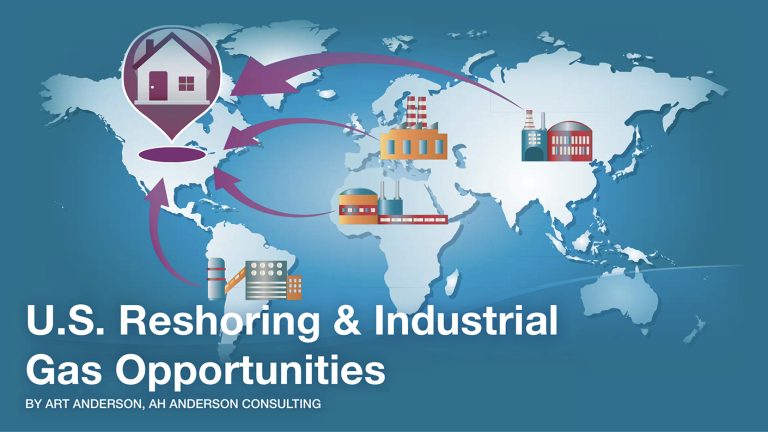For decades, companies across industries would seek out manufacturing possibilities around the world – taking advantage of less expensive labor, cheaper rents, and relaxed regulations. However, over the last 10 years or so, the tide has begun to turn, and companies are gradually bringing back more of their manufacturing operations to the U.S.
There are several reasons driving this shift including the shrinking delta in labor costs between U.S. vs. overseas locations, rising transportation costs, IP theft, and several others. But severe supply chain disruptions during the pandemic, which resulted in shortages of supplies coming from overseas, mostly due to Chinese factories closing, opening, and then closing again as COVID-19 outbreaks were happening every where, exposed risk as an important component in the decision on where to manufacture. More recently, it has been the rising geopolitical tensions/activities that threaten sunk investments in those countries (i.e., Russia/Ukraine, China/Taiwan, etc.) that are now accelerating this strategy shift. The trend has been further bolstered by legislative actions that are encouraging investment and offering incentives for operating facilities in the U.S., which is also happening in countries/regions around the world including the EU, Japan, China, etc. This is all good news for the manufacturing sector in the U.S. for the foreseeable future, and the industrial gas industry is positioned to benefit from this shift. This article will take a deeper dive into these trends called “reshoring;’ its drivers, company examples thus far, and the outlook and opportunities for companies in the industrial gas industry.

Trends
Let’s start off by defining what is “reshoring:’ It is the practice of bringing manufacturing and services back to the U.S. from overseas. But, in the broadest sense, it also includes new sourcing of raw materials and parts in the U.S., expanding operations in America vs. overseas, and foreign direct investment in American manufacturing. All these categories are potentially good news for the U.S. economy. The concept of reshoring has been around for some time, but the Reshoring Institute, whose mission is to bring good, well-paying manufacturing jobs back to the United States, started measuring this phenomena in 2010 and has been tracking a slow but gradual increase in facilities and jobs coming back to the U.S. as shown in the chart. The forecast by the end of 2023 is anticipated to be more than 400,000 jobs.
The drivers of this trend, as discussed before, have gradually shifted from being purely economic (total cost of ownership) to incorporating factors such as the risks of long global supply chains, order fulfillment times and geopolitical risk. The Russia/ Ukraine conflict is a perfect example of a completely unforecasted event that had significant impact to industries around the world. It continues to impact the supply/demand of the global Rare Gases industry (i.e., Krypton, Xenon, Neon) which is critical to many of our customers. And, more specifically, the top-3 players in our industry (Linde, Air Liquide and Air Products) had combined assets in Russia valuing over $1 Billion and have either had them frozen, divested, or are in the process of divestment, significantly impairing business performance.
The most recent drivers have been regulatory with new funding and tax incentives now available through the CHIPS and Science Act, the Inflation Reduction Act and the Build Back Better Infrastructure Act, which provide positive economic choices for U.S. manufacturers interested in reshoring operations.
Opportunities
The signing of the CHIPS and Science Act in August 2022 is but one example driving the momentum around reshoring. This legislation is set to direct $280 billion of spending in the next ten years for R&D workforce development and tax credits for chip production. Intel is already building two factories outside Phoenix, AZ and announced a greenfield factory near Colombus, Ohio. Taiwan Semiconductor Manufacturing (TSMC), the largest chip foundry in the world is constructing one in AZ. Micron announced in October 2022 that it plans to spend up to $100 billion constructing four semiconductor fabrication plants outside Syracuse, NY. The fabs would employ 9,000 people and create 40,000 spinoff jobs. Several other companies will benefit including Global Foundries, Texas Instruments, ON Semiconductor, Analog Devices, Microchip, KLA Corp., Applied Materials and Lam Research, among others. The Major industrial gas players may/will secure the long-term gas supplies for many of these projects, but Independent Distributors will play a significant role during the construction and ongoing operations/ maintenance phases of these facilities.
in the 1980s, 1990s and 2000s, offshoring was the name of the game in manufacturing. As with most things in life, times change and there is now a discernable shift to “reshoring” of manufacturing operations from overseas locations.
Pharmaceutical production is also seeing a rebound, especially after the pandemic exposed major risks in that supply chain. Plastics manufacturing is experiencing a return to American manufacturing, particularly products that require a rapid customer response time. Other industries such as aluminum and steel are seeing plants erected across the southern U.S., including Novelis in Bay Minette, Alabama, US Steel in Osceola, Arkansas, Nucor in Brandenburg, Kentucky (Nucor). These industries are fueling orders for air compressors that will be cranked out at an Ingersoll Rand plant in Buffalo, New York that had been shuttered for years. Again, this is all great news for the Industrial Gas industry and the Independent Distributor segment will get its fair share from these industries and its supplier base.
Next Steps
To best take advantage of the opportunities offered by reshoring there are a few steps that Independent Distributors can proactively take. In many respects it is Business development 101, with a few twists:
- Local/Regional Economic Development – Many of the larger reshoring opportunities are being developed and negotiated at the State or even Federal levels. But many opportunities engage through a regional/local economic development organization. Participation on one of the committees, Advisory Board or as an annual sponsor provides “early access” to prospective companies doing their due diligence regarding new locations. As an example, the Lehigh Economic Development Corporation (LVEDC) markets the economic assets of the Lehigh Valley, a two-county region in eastern Pennsylvania, located 60 minutes from Philadelphia, 90 minutes from New York City, and within a one-day drive of one-third of the U.S. population. Over the last decade, LVEDC has contributed to making this region the #2 ranked mid sized market in the US with manufacturing being the largest component of its GDP.
- Trickle Down Affect – Just because you may not be targeted or selected as the primary supplier for one of these large semiconductor fabs, steel mills, or automotive parts plants, they all have several suppliers who can use your products/services during the construction and ongoing phases of the projects. So, knowing the tier two and three suppliers, and general/mechanical contractors (who are often locally/regionally based) are potential avenues to secure sizable pieces of the business.
- Strategy – Pursuing these opportunities may be viewed as the territory of the Majors, but Independent Distributors can play a role especially if they have an advantage in local/regional infrastructure. As with any significant opportunity strategy is the first step. You must determine if your pursuit is aligned with your company’s business strategy (i.e., targeted end-markets, aligns with strengths and core competencies, and leverages local infrastructure). But then do your homework on the realistic opportunities available at the Tier 1, 2 and 3 supplier levels, the amount of investment in people and infrastructure (if needed), and determine what makes sense for your business. More often than not an external advisor may be able to assist in this analysis, especially if it is an end-market or technology with which you have limited knowledge or experience.
In closing, in the 1980s, 1990s and 2000s, offshoring was the name of the game in manufacturing. As with most things in life, times change and there is now a discernable shift to “reshoring” of manufacturing operations from overseas locations. AI (artificial intelligence) may be the biggest tech trend of 2023, but U.S. reshoring is shaping up to be the biggest market trend of this entire decade. It is great news for the manufacturing sector in the US and is expected to bolster industrial production output in 2024 and beyond. In addition, this bodes well for the entire industrial gas industry since our performance and growth is significantly tied to this sector.




